Speech Australia and Canada – Comparing Notes on Recent Experiences

Glenn Stevens [1]
Governor
Remarks to the Canadian Australian Chamber of Commerce
Canada-Australia Breakfast
Sydney –
- Audio 25.9MB
- PDF version 197KB
Thank you for the invitation to be here. As a one-time temporary resident of Canada and graduate of a Canadian university, it is pleasing for me to see the Canadian Australian Chamber of Commerce contributing to economic interaction between the two countries.
It is surprising that Australians and Canadians do not spend more time comparing notes, given the things we have in common. Apart from a shared heritage as members of the British Commonwealth (though Canada, of course, has the French-speaking heritage as well),[2] we are both federal states and constitutional monarchies. Both nations have relatively small populations that occupy physically large continents. We are both commodities producers. Our economies are open, and free flows of trade and capital are very important to us.
There are some interesting similarities, and the occasional informative difference, in experiences, and examining these is helpful for Australians to understand better the way the past six or seven years have evolved. I propose to look at some of those today.
Looking to the future, both our countries have reason to believe that we will come through this episode in reasonable shape. We also have important shared interests in the way the international economic and financial system evolves over the years ahead. In canvassing some of these issues, I am mindful that David Dodge, the former Governor of the Bank of Canada, spoke to this group only a few years ago, concerning many of the same questions.[3] I find myself agreeing with the sentiments he expressed then, and repeating many of them today.
Similarities, differences and recent developments
Australia and Canada have similar levels of GDP per capita (based on purchasing power parity, nominal GDP per capita was around US$37,000 for Australia and US$39,000 for Canada in 2008). Since 1990, Australia's growth in real GDP per capita has been a little higher than Canada's.
In terms of economic structure, the primary production sectors, combined, are of similar size in the two countries (Table 1). Australia has less manufacturing, but more mining than Canada. There are also some notable differences in the composition of our mining sectors. Both these turn out to have been of some importance over recent years, as I shall point out shortly. But, overall, the economic structures of the two countries at a very broad level are reasonably similar and, beyond the resource sector concentration, not all that different from the ‘norm’ among industrialised economies.
| Canada | Australia | |
|---|---|---|
| Manufacturing | 15.2 | 10.6 |
| Mining(b) | 4.5 | 8.4 |
| Agriculture, forestry and fishing | 2.1 | 2.5 |
| Total of above | 21.8 | 21.5 |
| Finance, property and business services | 19.1 | 21.2 |
| Health, education and community services(c) | 15.0 | 14.3 |
| Wholesale and retail trade(d) | 14.9 | 12.8 |
| Total of above | 49.0 | 48.3 |
| Construction | 6.1 | 7.8 |
| Utilities and transport | 6.6 | 7.3 |
| Government administration and defence | 5.7 | 4.0 |
| Communication services | 2.8 | 2.7 |
| Other | 8.0 | 8.4 |
| (a) At basic prices (excludes taxes and subsidies on products); Canadian industry
classifications modified to match Australian standards (b) Includes energy sector activities such as oil and gas extraction and coal mining (c) Includes cultural, recreational and personal services (d) Includes accommodation, restaurants, cafes and bars |
||
Trade and financial flows between Australia and Canada are small – Canada accounted for around 1 per cent of Australia's merchandise exports and imports in 2008, and around 1 per cent of foreign investment received by Australia.
But trade overall is very important to Australia, and even more so to Canada. Exports of goods and services amounted to just under a quarter of Australian GDP in 2008 and more than a third of Canadian GDP. Commodities make up a significant share of the value of merchandise exports in both countries, although they are rather more important to Australia, as Canada also has sizeable exports of machinery, equipment and cars (Table 2). The composition of the two countries' commodity exports differs somewhat – Canada's exports include a larger share of crude oil, natural gas and forestry products, while Australia has a larger share of exports in coal, iron ore and many metals.
| Canada | Australia | |
|---|---|---|
| Crude oil | 12 | 5 |
| Natural gas | 7 | 4 |
| Coal | 6(b) | 21 |
| Iron, iron ore and steel | 3 | 15 |
| Aluminium | 2 | 6 |
| Precious metals | 2 | 7 |
| Nickel | 2 | 1 |
| Copper | 1 | 3 |
| Sub total | 35 | 61 |
| Agricultural and fishing products | 8 | 11 |
| Forestry | 5 | 1 |
| Sub total | 14 | 12 |
| Machinery and equipment | 19 | 5 |
| Automobiles | 12 | 2 |
| Sub total | 31 | 7 |
| Other(c) | 20 | 20 |
| Total | 100 | 100 |
(a) Data may not be strictly comparable owing to differences in classification
standards; ores, concentrates and scraps are included in the category
for each metal Sources: ABS; Thomson Reuters |
||
Commodity prices tend to vary quite a bit, of course, driven largely by the ebb and flow of the world business cycle. This means that fluctuations in the terms of trade have long been an important feature of both countries' economic experiences. For many years, the movements seemed to be quite similar – at least until the international downturn of 2001 (Graph 1).
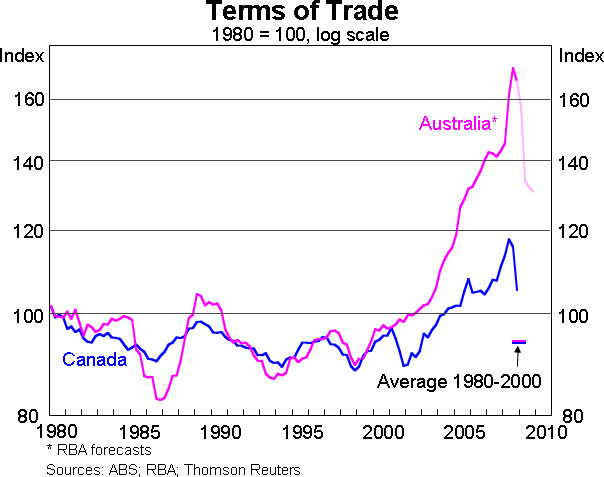
In the subsequent global upswing, while both countries saw their terms of trade increase, Australia's terms of trade began to pull ahead of Canada's. Between the beginning of 2002 and the middle of last year, the Canadian terms of trade had risen by more than 30 per cent. But over the same period, the Australian terms of trade rose by over 60 per cent.
Why the difference? The answer is that the more rapid rise for Australia reflected the fact that our exports have a higher share of commodities, and within that, a higher weighting towards the commodities that had experienced the largest price increases (Table 3). That said, since Canada's trade share of the economy is considerably larger than Australia's, the smaller size of the terms of trade rise in Canada still imparted a pretty significant boost to national income.
| Year average | ||||
|---|---|---|---|---|
| 2000 | 2004 | 2008 | ||
| RBA Index of Commodity Prices | USD (2000 = 100) | 100 | 137 | 312 |
| BOC Index of Commodity Prices | USD (2000 = 100) | 100 | 129 | 219 |
| Oil (WTI) | US$/bbl | 30 | 41 | 100 |
| Gas (Henry Hub) | US$/thousand m3 | 155 | 213 | 319 |
| Thermal Coal (Newcastle spot) | US$/tonne | 24 | 54 | 129 |
| Hard Coking Coal (contract)(a) | US$/tonne | 40 | 57 | 300 |
| Iron ore (contract)(a) | USc/dmtu(b) | 27 | 36 | 145 |
| Aluminium (LME) | US$/tonne | 1550 | 1719 | 2576 |
| Copper (LME) | US$/tonne | 1814 | 2864 | 6957 |
(a) Contract price based on Japanese fiscal year beginning 1 April Sources: ABARE; Bank of Canada; Bloomberg; IMF; RBA |
||||
Income gains driven by the terms of trade are generally expansionary. The boost would be expected, other things equal, to result in stronger growth in demand and output relative to capacity, more risk of inflation, higher interest rates and a rise in the exchange rate, relative to countries that did not share the shock.
So it seemed to turn out. In the phase of the terms of trade upswing, both our countries saw growth above average, interest and exchange rates rising and some upward pressure on inflation. There were, nonetheless, some differences. The Australian dollar did not rise as much as the Canadian dollar, which is a bit surprising given Australia's greater rise in the terms of trade. Australia also saw somewhat higher growth in demand on average during the 2002 to 2008 period than Canada. Associated with those trends was a more pronounced rise in inflation at the end of the upswing, which saw us deviate further from our inflation target than Canada (Graph 2).
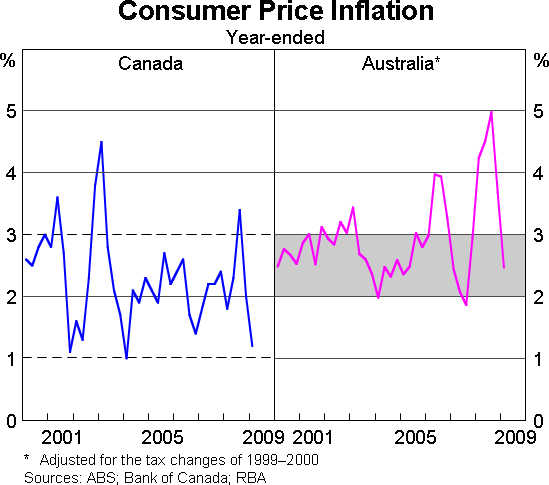
That said, Australia coped with the terms of trade upswing better this time than in some past episodes. An inflation peak at around 5 per cent in 2008 compares to around 25 per cent in the commodities boom of the early 1950s and 18 per cent during the boom in the mid 1970s (Graph 3). Several economic reforms contributed to this improvement – including the floating exchange rate, more flexible labour market and stronger monetary policy framework.
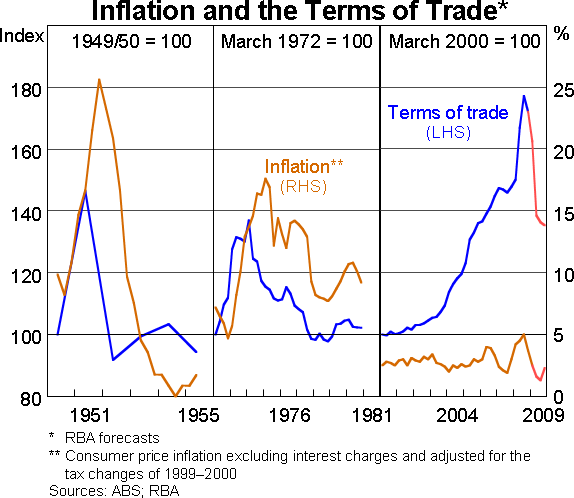
More recently, the impetus from the global economy has reversed direction for both countries as a result of the global recession. Canadians would have sensed the change first, reflecting Canada's very close ties with the United States – which absorbs around three-quarters of Canada's merchandise exports, equivalent to around a quarter of its GDP. The economic weakness in the United States began to take root as problems in its housing sector and financial system emerged in 2007, reducing demand for Canadian exports and weighing on growth, even with the booming terms of trade.
In Australia's case, exports are not as large a share of the economy, as noted, and the destinations are both more diverse and more oriented to Asia (China and Korea account for more than a fifth of the value of Australian merchandise exports, and Japan accounts for another fifth). Overall, Asia was initially relatively little affected by the problems in the major economies. It was really only in the second half of 2008, as the financial turmoil led to a sharp drop in confidence among households and firms around the world, that a re-assessment about Asia's prospects began.
Even then, Australia's export volumes have not weakened to date as much as those of many other countries (Table 4).
| Taiwan(a) | −17.8 |
|---|---|
| Malaysia(a) | −14.2 |
| Japan | −13.9 |
| Thailand(a) | −10.9 |
| Singapore(a) | −10.2 |
| South Korea | −8.9 |
| China(a,b) | −7.5 |
| Italy | −7.4 |
| Germany | −7.3 |
| United States | −6.5 |
| Indonesia(a) | −4.7 |
| Canada | −4.7 |
| France | −4.6 |
| United Kingdom | −3.9 |
| Hong Kong(a) | −3.5 |
| Australia | -0.8 |
(a) Seasonally adjusted by the RBA Sources: ABS; CEIC; Thomson Reuters; RBA |
|
One reason is that the slump in global trade was initially concentrated heavily in manufactures, which is a smaller share of exports for Australia than others. Another is the stronger linkage of key commodity exports to China, which appears to have seen a pick-up in growth this year. Chinese industrial output fell for four months between July and November, but has since recovered all those losses. A similar pattern has been seen in Korea, where industrial output suffered a sharp decline around year end but apparently made up about half of that over February and March.
Looking ahead, with commodity prices at present levels, Canada's terms of trade look like they are still somewhat above the average for the preceding couple of decades. Australian resource producers have accepted lower prices for the year ahead, and this is likely to contribute to a decline in the terms of trade by the end of 2009 of about 25 per cent from the peak, as shown in the chart. Yet even with that, at this stage Australia's terms of trade over the coming year look like they will still be around 40 per cent above the two-decade average up to 2000.
So in some important respects, not only did the economic upswing that ended during 2008 provide a bit more impetus to Australia than Canada, but the ensuing global economic downturn has not, to date at least, hit Australia as hard as it has Canada. On a comparison of these two countries, the effects of export volume losses in slowing overall demand in the economy have been less important in Australia.
As for inflation, it has moderated. The headline figures overstate the fall in inflation in both countries because of the decline in petrol prices, but measures of core or underlying inflation are trending lower. Of course in Australia, inflation has further to fall than in Canada, since it reached a higher peak.
Key strengths
One important feature that our two countries share at present is the relative resilience of our banking sectors.[4] Notwithstanding the global credit crisis, Canadian and Australian banks continue to be profitable and are well capitalised by private investors – something that many advanced countries cannot claim. For the 2008 reporting period, the return on equity for the five largest Australian banks was 17 per cent, and it was 14½ per cent for Canada's major banks. This was lower than in the preceding few years, which had been ones of exceptional profits for banks around the world – and years during which, in retrospect, risk was increasing – but still very solid. It is noteworthy that equity market valuations of the two banking systems display more confidence in asset quality and potential future earnings than for US, European or UK banks, as judged by the market premium over book value (Graph 4).
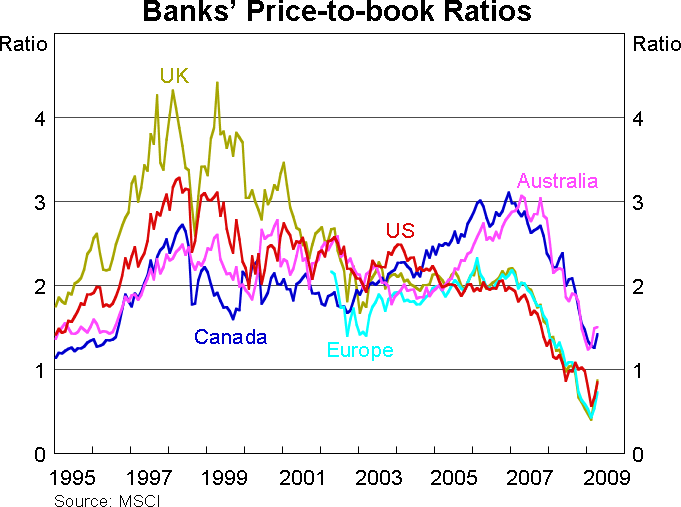
The solid performance of these banks reflects a number of factors. Firstly, holdings of the complex securities at the centre of the crisis were modest by international standards.
Secondly, banks in Australia and Canada had more conservative lending practices in their home markets than their counterparts in the United States and the United Kingdom. While sub-prime mortgages accounted for around 13 per cent of the US mortgage market in mid 2007, the closest equivalents in Australia and Canada accounted for around 1 per cent and less than 5 per cent of their mortgage markets, respectively.
Both countries have had regional booms in housing markets in the past few years, associated with the run-up in commodity prices and the associated effects of the shift in productive resources to those industries and regions that were enjoying the boom. Hence, house prices in Alberta and in Western Australia had a large run-up compared with most other regions in the respective countries (Graph 5). More recently, dwelling prices generally have tended to soften. In Australia's case, the ratio of the median dwelling price to average household income has declined quite noticeably since 2003, without a very large absolute decline in housing prices (Graph 6). This is evidence for at least the possibility that these adjustments can take place over reasonably lengthy periods and without being terribly disruptive to the economy.
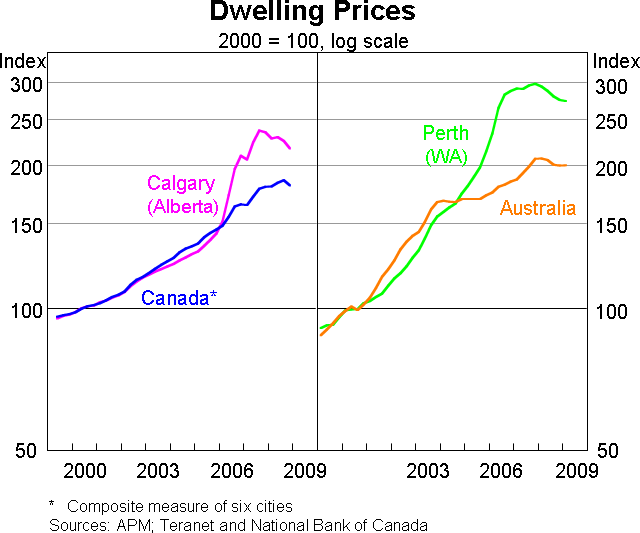
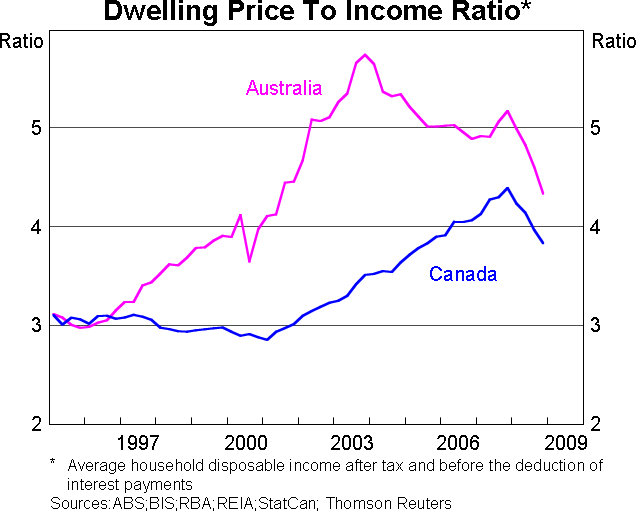
Of course, with the economy contracting at present, banks in both countries are seeing some pick-up in mortgage arrears. Overall, though, Australian and Canadian households appear to be having much less trouble servicing their debt than is the case in the United States and the United Kingdom, as shown by their relatively low rates of non-performing housing loans (Graph 7). This reflects the better lending decisions in earlier years.
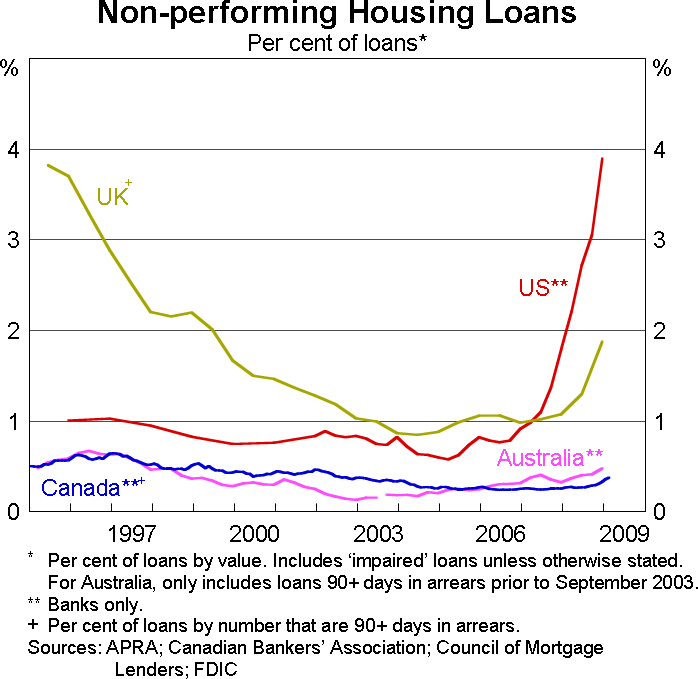
Our common external interests
Of course, good domestic policies can do only so much to ameliorate the impacts of very adverse international developments. Both economies have slipped into recession as international forces have taken hold, albeit through differing chains of causation. But for the reasons articulated above, there are good grounds to think that both countries should be in a relatively good position and well placed to take part in a renewed international expansion. It is too soon to say this is beginning yet, though developments over recent months are certainly consistent with the view that a recovery will get under way towards the end of the year. That said, most observers think that the early part of any new global expansion will be characterised by pretty slow growth.
Even with the uncertainty over the near-term global outlook, however, it makes sense to look forward. So in the final part of this address, I should like to talk about the common interests we have at stake in the way the international community responds to the crisis and shapes the next expansion.
First among these is the openness of trade and capital flows. The extent to which trade flows slumped late last year perhaps gives a sense of what could happen were trade barriers to go up. Everyone would suffer, and badly. This is fully understood at an intellectual level around the world. Yet we know that in times of domestic economic difficulty, the pressures for protectionism increase. Countries like ours need to keep making the point that trade is not a zero-sum game; it is collectively a positive-sum process that stimulates innovation and productivity, increases global growth and raises living standards.
Secondly, the continued development of many emerging economies will enrich the opportunities for firms and individuals in economies like ours over time. But it will be sensible for emerging countries to have strategies that rely less on the absorption of consumer products by the developed world, at least for some years. That will involve, roughly speaking, more consumption and investment at home, lower trade surpluses and a step back from very large outflows of capital to the developed world. This is actually a rational choice for emerging market countries. But a lesson many countries took from the Asian crisis was that a strategy such as that was dangerous, because the rules of international engagement did not provide adequate protection in times of difficulty. Their response was the build-up of reserve assets in the period since 1998 – a costly form of international self-insurance, involving sending hard-saved capital from developing economies to the rich world. It was very much a second-best option but was pursued because first-best seemed unachievable.
So it is in the interests of many developing countries to alter their growth strategy, but to do so they need confidence in the international system – its rules, governance, safety nets and so on. At the same time, the countries that have dominated the governance arrangements hitherto, and which will have to accommodate the emerging countries, will want to have some confidence that we are all – emerging markets and developed countries alike – reading from the same page about the role and responsibilities of the international financial institutions and their member states. Australia and Canada have a shared interest in fostering progress on these fronts, which will involve encouraging both emerging countries and highly developed countries to move in ways that accommodate each other. I know my Canadian counterparts have worked assiduously on these issues for many years. We support those efforts.
Thirdly, much work is being done on the lessons we can learn from this episode for financial regulation and structure. As countries whose financial and regulatory systems have performed pretty well in this episode, and which are largely free of serious problems, Australia and Canada are perhaps uniquely placed to contribute to the discussion. I think we could hope to bring a sense of emotional detachment, balance and perspective to the international discussions on regulatory reform, which can be quite heated at times.
Conclusion
The ‘great white north’ and the ‘great south land’ have much in common, as well as some very informative differences. Sound policy frameworks and robust business sectors are being tested at present, but they can meet the test.
We both certainly have, at this juncture, much at stake in the global economy recovering to a path of balanced growth, with open markets and sustainable policy settings. There is plenty we can do together to promote our common interests in the world, as well as our own interaction. Part of this sharing of ideas and co-operation will be spurred on by forums such as this one. I wish you every success.
Endnotes
I thank Kathryn Ford and Jennie Cassidy for assistance in preparing these remarks. [1]
Canada is, of course, famously bilingual. In both countries, Chinese languages (that is, Cantonese, Mandarin and other Chinese languages) are the most commonly spoken languages after English (and after French in Canada). [2]
Dodge D (2006), ‘Prospering in Today's Global Economy: Challenges for Open Economies such as Australia and Canada’, address to the Sydney Institute and the Canadian Australian Chamber of Commerce, 6 November. [3]
The six largest Canadian banks account for around 90 per cent of Canadian banking system assets. Following recent mergers, the four largest Australian banks account for around 70 per cent of Australian banking system assets. [4]